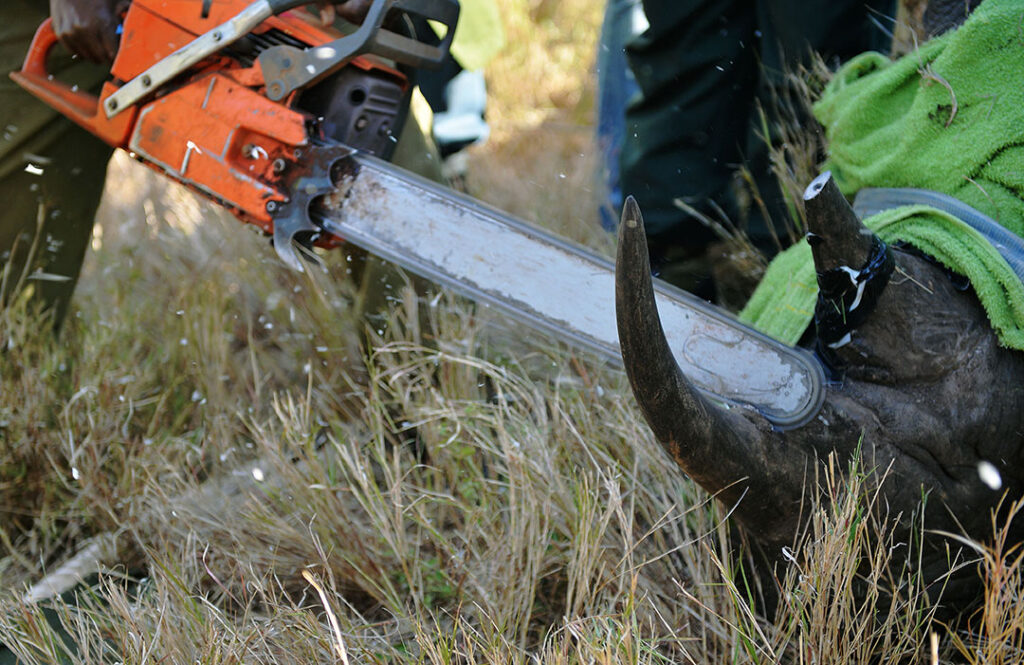ADF STAFF
In two days in mid-July, customs officials at O.R. Tambo International Airport outside Johannesburg, South Africa, seized two large shipments of rhino horn. One was disguised as fine art, the other as scaffolding equipment.
Destined for Malaysia, the illicit cargo was valued at 115.7 million South African rand, or more than $6.8 million.
Africa’s rhinoceros population is facing a grave threat. It’s traditional Chinese medicine (TCM), a huge industry that aggressively promotes rhino horn as a treatment for COVID-19, the disease caused by the coronavirus that originated in China.
At the turn of the 20th century, Africa and Asia were home to about 500,000 rhinos. Today, as few as 29,000 remain in the wild, according to the World Wildlife Fund (WWF).
In Africa, the black rhino is classified as “critically endangered” with about 5,000 remaining in the southern part of the continent. The white rhino is considered “near threatened” with its numbers as low as 17,000. The western black rhino and northern white rhino subspecies are now extinct in the wild.
The greatest danger to rhinos is poaching. Interpol estimates the value of the illegal wildlife trade to be $10 billion to $20 billion a year.
Chinese consumers “are a primary source of demand for many species, which are seriously threatened by illegal harvesting and trafficking,” wrote Aron White, a China specialist for the Environmental Investigation Agency (EIA), in a report for British security think tank Royal United Services Institute. “In many cases, an inescapable factor in this demand has been official policies which legitimize commercial exploitation of threatened wild animals.
“Support for commercialization of threatened wildlife is pervasive within key government institutions supposedly tasked with the protection of wildlife.”
Rhino horn is mostly made up of keratin, a protein found in human fingernails and hair. For centuries, it has been a key ingredient in TCM, despite numerous scientific studies proving it has no medicinal value.
“Rhino horn is of no use to anyone except the original owner,” Dr. Arne Schiotz wrote in a WWF study. “You would get the same effect from chewing your own fingernails.”
Still, China’s National Health Commission in January recommended approved treatments for COVID-19 that included Angong Niuhuang Wan as a way to reduce fever.
It is packaged as small medicine balls made with herbs, minerals and, traditionally, rhino horn powder. Rhino horn is a banned trade substance, so Chinese law requires these pills to contain buffalo horn.
But sellers in China have recently advertised the product on social media platform WeChat with rhino horn among the ingredients, according to EIA.
“There’s a consistent preference among consumers for the wild product, which is often regarded as more powerful or ‘the real deal,’” White told National Geographic, adding that “it actually just maintains demand that drives poaching.”
Since COVID-19 was discovered in Wuhan, China, more than 20 million cases have been reported around the planet, and more than three-quarters of a million people have died as of mid-August, according to Johns Hopkins University’s COVID-19 tracker.
China banned wildlife consumption and trade in February to thwart the spread of the virus. But among the many loopholes are TCM and biomedical research.
“Restricting the eating of wildlife while promoting medicines containing wildlife parts exemplifies the mixed messages being sent by Chinese authorities on wildlife trade,” White said on EIA’s website.
“Aside from the irony of promoting a wildlife product for treatment of a disease which the scientific community has overwhelmingly concluded originated in wildlife, the continued promotion of the use of threatened wildlife in medicine is hugely irresponsible in an era of unprecedented biodiversity loss, including illegal and unsustainable trade.”

